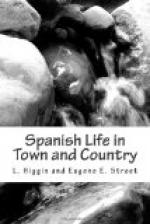The Madonna, who is always spoken of as “La Virgen,” never as “Santa Maria,” is the great object of love and of reverence in Spain, while the words Dios and Jesus are used as common exclamations in a way that impresses English people rather unfavourably. It is a shock to hear all classes using the Por Dios! which with us is a mark of the purest blackguardism, and the use as common names of that of Our Lord and of Salvador, or Saviour, always strikes a disagreeable note. There is in Madrid a “Calle Jesus,” and the sacred name, used as a common expletive, is heard on all sides. One of the most charming of Yradier’s Andalusian songs, addressed by a contrabandista to his novia, runs thus:
Pero tengo unas patillas.
Que patillas punala!
Es lo mejor que se ha jecho
En de Jesu Cristo aca![2]
[2] “But I have such
a stunning pair of whiskers!
The
best that have ever been seen since those of Jesus
Christ!”
And no one is offended; in fact, no irreverence is probably meant.
But the innumerable “Virgenes” which abound throughout the country, and all seem different, have the heartfelt devotion of all classes. To one or other of them the bull-fighter goes for protection and aid before he enters the arena; the mother whose child lies sick vows her magnificent hair to the Virgin of the Atocha, or of the Pillar, or some of the many others scattered about the country, if only she will grant what she asks; and you may see these marvellous locks, tied with coloured ribbons, hanging amongst the motley assemblage of votive offerings by the side of her altar, when the prayer has been answered. It is difficult for us, with the best intentions, not to let prejudice colour our judgment, and to understand what we are told—that these are really all the same “Mother of God”; for, if so, one would imagine that she would hear the devout prayers of her worshippers, to whichever of the wooden images—most of them said to have been carved by St. Luke, and black by age, if not by nature—they are addressed. But no, the Virgen del Carmen is only efficacious in certain circumstances; and in the time of Isabel II. she used to be taken down from her altar and placed in the Queen’s bedroom whenever an addition to the Royal Family was imminent. Those in the other parts of Spain have each their specialty, and pilgrimages are necessary to their shrines before the prayers addressed to them can be listened to by the original.
The various saints in their way are wooed with candles burnt before their images, or little altars set up to them at home; but they are sometimes treated with scant courtesy if they do not answer the expectations of their worshippers. On one occasion in Madrid, I remember, San Isidro, who is the patron of the labouring classes, had the bad taste, as his votaries considered, to send rain on his own fiesta—a




